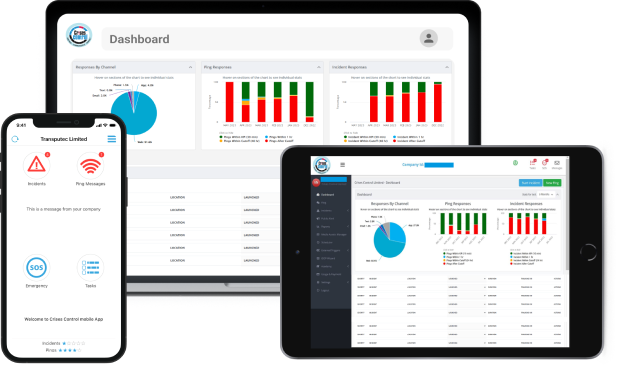Written by Anneri Fourie | Crises Control Executive
Crisis Management Software is critical when every second counts in an emergency. Imagine it is the middle of the night when suddenly your organisation is hit by a ransomware attack. Your crisis plan sits somewhere on a shared drive, buried in a folder no one can find quickly. Your key team members are scattered across multiple email threads and messaging platforms, each trying to piece together what to do next. Valuable minutes slip by as messages get lost and confusion grows. By the time everyone is on the same page, the damage has already increased. This scenario is far too common for organisations still relying on disconnected tools for crisis response.
Now imagine a different reality where the alert pops up directly inside the Microsoft Teams app your staff already use every day. The right people are immediately notified and can see what actions to take next without switching between apps. Updates flow in real time, and everyone knows who has acknowledged alerts and who is working on what. The crisis plan plays out smoothly, tasks are assigned automatically, and no one wastes time searching for information.
This is the kind of seamless, fast, and reliable response Crises Control’s crisis management software delivers, and now it comes with full integration into Microsoft Teams. If your organisation uses Microsoft 365, this new integration brings your crisis communication and incident management into one familiar platform, helping your teams act faster, collaborate better, and reduce risk.
Why You Need Crisis Management Software that Works with Your Tools
Crisis situations are stressful and unpredictable. Every second counts when you need to notify people, coordinate actions, and make critical decisions. The tools you use for this must be reliable, clear, and fit naturally into your existing workflows. Unfortunately, many organisations still struggle with outdated methods such as mass emails, phone trees, or generic chat apps that were never designed for emergencies.
Crisis management software is not about adding complexity; it is about simplifying communication and control in a crisis. It centralises alerts, automates workflows, and keeps everyone informed. But if your crisis software works in isolation, requiring teams to jump between platforms, much of its value is lost.
By integrating with Microsoft Teams, Crises Control eliminates this barrier. Since many organisations use Teams as their primary communication hub, this integration means you can keep your crisis response where your people already collaborate daily. There is no need to learn new apps or switch context in a stressful situation, which is crucial for quick and effective incident management.
What the Microsoft Teams Integration Means for Crisis Response
Crises Control now includes Microsoft Teams as a push notification channel alongside email, SMS, phone calls, and mobile app alerts. This is not just about sending a message to Teams; it turns Teams into an active part of your crisis command centre.
Here is how it works:
- Push notifications arrive directly in Microsoft Teams chats or channels so users see critical alerts where they already work. This increases visibility and helps users respond faster.
- Users can acknowledge alerts and reply within Teams, enabling quick confirmation of receipt and communication without needing to switch apps.
- All critical notifications and instructions are delivered through the platform to streamline awareness and action.
- Task progress and detailed updates remain in the Crises Control platform, while Teams acts as the real-time alert and response channel.
Since this integration uses the Microsoft 365 environment your organisation already has, there is no need for complex setups or additional logins. It simply makes your crisis communication smarter, faster, and more connected.
How Integrating Microsoft Teams with Crises Control Improves Incident Management
1. Respond Faster with Less Friction
Switching between multiple tools wastes precious time and creates confusion during a crisis. Integrating Teams notifications means your people get the right message in the right place, every time. When a critical alert appears in Teams, users can immediately acknowledge it and begin assigned actions. This reduces delays caused by missed emails or overlooked phone calls.
2. Work Together Without Barriers
A crisis cannot be handled alone. Clear communication is essential. With Crises Control alerts appearing directly in Microsoft Teams, your teams are instantly aware of incidents without switching platforms. They can acknowledge and respond to alerts where they already work, ensuring key messages don’t get buried in inboxes or missed entirely. Teams serves as a familiar, fast-touch channel to keep everyone in the loop when every second matters.
3. Improve Visibility and Accountability
Leaders need to know who has seen alerts, who is acting on them, and what progress has been made. Crises Control provides detailed tracking and audit trails for every notification and task, even when it flows through Teams. This creates an accurate record for post-incident reviews and helps meet compliance requirements.
4. Simplify Setup and Use
Crises Control’s Teams integration is straightforward to enable for organisations with Microsoft 365 accounts. Admins select which Teams channels or users will receive alerts, customise messages, and test workflows. Because it builds on your existing Microsoft infrastructure, there is minimal disruption to your IT environment or user habits.
Already a Crises Control Customer?
Setting Up Crises Control and Microsoft Teams Integration
Getting started is quick and easy:
- Verify your organisation uses Microsoft Teams with active user accounts.
- Enable the Teams notification method inside the Crises Control administration dashboard.
- Configure which Teams channels or individuals should receive alerts and notifications.
- Test your setup by sending a simulated alert to confirm messages appear as expected in Teams.
- Train your crisis teams to acknowledge alerts and update task progress from within Teams.
Because the integration sits on top of Microsoft 365, you avoid complicated software installs or managing new user credentials. The learning curve for your staff is minimal since they already use Teams for collaboration.
Why Crises Control Is the Right Choice for Your Crisis Management Needs
Not all crisis management software is built the same. Crises Control stands out because it is designed from the ground up to manage complex incidents with precision and flexibility. By integrating with Microsoft Teams, it plays to your organisation’s existing strengths rather than adding new hurdles.
Key reasons organisations choose Crises Control include:
- Tailored Incident Workflows: Automate response plans that match your unique risks and organisational structure.
- Multi-Channel Alerts: Reach users through their preferred methods to ensure no one misses a critical message.
- Audit-Ready Reporting: Maintain a detailed log of every alert, action, and communication for compliance and review.
- User-Friendly Interface: Intuitive dashboards for crisis leaders, responders, and support staff alike.
- Scalable for Any Size Organisation: From small teams to multinational corporations, Crises Control adapts to your needs.
Take Control of Your Crisis Response Today
The reality is simple: relying on disconnected apps and manual processes leaves your organisation vulnerable when incidents occur. Crises Control’s crisis management software combined with Microsoft Teams integration gives you one clear, reliable way to alert, inform, and mobilise your teams.
This is more than just adding another communication channel. It is about making your incident response smarter, faster, and more effective by bringing it directly into the collaboration space your people already use.
If you want to see how quickly your crisis response can improve with this integration, contact us today to arrange a free live demo. Let us show you how to turn Microsoft Teams into your crisis command centre and launch coordinated responses in under a minute.
Request a FREE Demo

